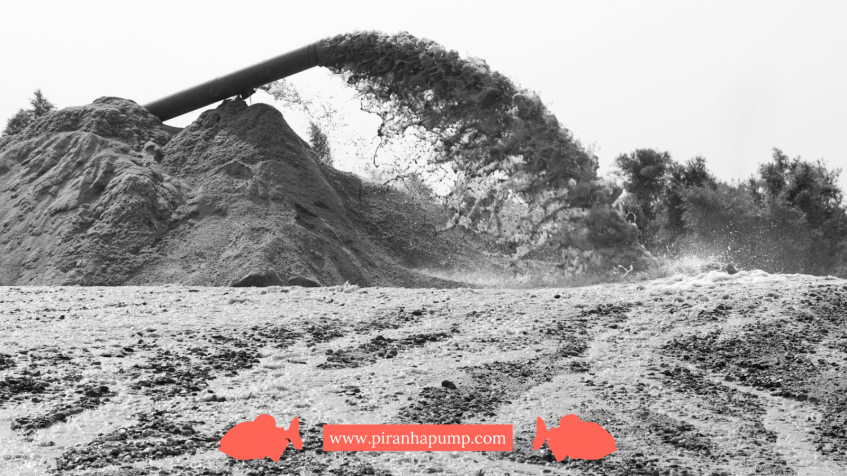If you’re planning a dredging project, one of the first questions you’ll need to answer is: what kind of material am I actually moving? It’s easy to group sand and gravel together–after all, they look quite similar. But when it comes to dredging, they respond in very different ways—and choosing the wrong equipment can create expensive problems.
In this guide, we’ll break down the key differences between sand dredging and gravel dredging, explore the challenges of each, and look at which sediment removal techniques work best. Whether you’re a construction manager working on a high-stakes project or a property owner trying to restore a pond, this information will help you confidently decide on the right equipment for the job.
Why It Matters: Sand Isn’t Gravel
The bottom line is this: sand and gravel don’t just look different, they act differently when you try to move them.
- Sand is fine, uniform, and relatively light. It moves more easily through pipes and hoses, but it can still be abrasive.
- Gravel is heavier, chunkier, and irregularly shaped. It doesn’t pump as smoothly and can put a serious strain on the wrong equipment.
Think of it like the difference between moving cornmeal and moving pebbles. You wouldn’t use the same tool for both—so you shouldn’t use the same dredging setup either.
Sand Dredging: Easier, But Still Demanding
Sand is typically easier to dredge than gravel because of its fine texture. That’s why sand dredging is common in projects like:
- Preparing construction sites
- Beach nourishment and shoreline restoration
- Land reclamation projects
- Pond or lake maintenance
What you have to watch out for with sand is abrasion. Even though sand is small, it wears down pump parts over time, especially impellers. At Piranha Pumps, we’ve developed a corrosion-resistant pump so that you can have dredging equipment built with abrasion resistance in mind. The right pump can handle large volumes of sand without constant breakdowns, which keeps your project moving smoothly.
Gravel Dredging: Heavier Lifting, Heavier Equipment
Now let’s talk about gravel. Gravel dredging is a different beast entirely. Those larger, irregular particles are not only heavier, but they also cause impact damage inside the pump if the equipment isn’t designed for solids handling.
You’ll usually see gravel dredging in:
- Mining and aggregate recovery
- Excavation and site prep
- Industrial projects where large particles need to be relocated
Because gravel requires more horsepower and more rugged components, you need heavy-duty dredging equipment with larger intakes, reinforced housings, and pumps capable of moving big solids without clogging. If you use a sand-only pump for gravel, you’re flirting with the possibility of wrecking the equipment outright.
Comparing Sand vs. Gravel Dredging Equipment
Here’s a quick breakdown of how the two compare:
| Factor | Sand Dredging | Gravel Dredging |
| Material | Fine, uniform | Large, irregular |
| Ease of Pumping | Flows more easily | Much harder to move |
| Equipment Stress | Moderate abrasion | High abrasion + impact |
| Best Equipment | High-volume, abrasion-resistant pumps | Heavy-duty dredges with solid-handling capacity |
| What Can Go Wrong | Premature wear, reduced efficiency | Clogging, pump failure, costly downtime |
What Happens If You Choose the Wrong Equipment
We want your projects to go as smoothly as possible, and choosing the wrong equipment can really throw a wrench in things. For example, let’s imagine you’re working with gravel, but you’ve chosen equipment that’s only really suited for sand. What could happen?
- Pumps clog or break down entirely
- Workers lose time unclogging and repairing equipment
- Project costs balloon from replacement parts and delays
- In worst cases, equipment failure can pose safety risks
On the other side of the coin, overbuilding—choosing heavy-duty gravel dredging equipment when all you need is sand removal—can also waste money. You’ll be paying for capacity and durability you don’t actually need.
We’re here to help you find the sweet spot. When you fully understand your site conditions, you can match your dredging equipment to the actual material you’re working with.
Choosing the Right Solution for Your Dredging Needs
If you’re tackling sand dredging, you’ll want equipment designed for high-volume movement of fine, abrasive particles. If your project requires gravel dredging, you’ll need something with sufficient power and solid-handling capability.
When you work with a trusted manufacturer like Piranha Pumps, it makes all the difference. Our line of dredges and pumps includes solutions built specifically for fine sediment removal as well as heavy-duty units capable of handling larger, tougher materials like gravel, and our team is ready to help you find the perfect equipment for your project. Reach out today!
Not sure which side your project falls on? That’s normal. Many sites contain a mix of materials, and the right solution may involve equipment that can handle both. The good news is you don’t have to figure it out alone—our team can help you assess your conditions and recommend the best approach.
Are you ready to get started? Whether your project calls for sand dredging, gravel dredging, or a combination of both, Piranha Pumps has the equipment and the know–how to help you do it right the first time. Contact us today to discuss your parameters so that we can help you find the best sediment removal techniques and equipment for your needs.
 PIRANHA
PIRANHA
